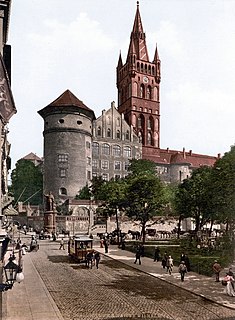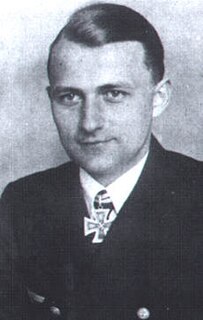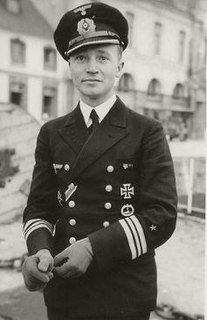| 32. Unterseebootsflottille | |
|---|---|
| Active | April 1944–May 1945 |
| Country | Nazi Germany |
| Branch | Kriegsmarine |
| Type | U-boat flotilla |
| Garrison/HQ | Königsberg (April 1944–January 1945) Hamburg (January–May 1945) |
| Commanders | |
| Notable commanders | Korvkpt. Ulrich Heyse (March–May 1945) |
32nd U-boat Flotilla ("32. Unterseebootsflottille") was a training flotilla ("Ausbildungsflottille") of Nazi Germany's Kriegsmarine during World War II.

Nazi Germany is the common English name for Germany between 1933 and 1945, when Adolf Hitler and his Nazi Party (NSDAP) controlled the country through a dictatorship. Under Hitler's rule, Germany was transformed into a totalitarian state that controlled nearly all aspects of life via the Gleichschaltung legal process. The official name of the state was Deutsches Reich until 1943 and Großdeutsches Reich from 1943 to 1945. Nazi Germany is also known as the Third Reich, meaning "Third Realm" or "Third Empire", the first two being the Holy Roman Empire (800–1806) and the German Empire (1871–1918). The Nazi regime ended after the Allies defeated Germany in May 1945, ending World War II in Europe.

The Kriegsmarine was the navy of Nazi Germany from 1935 to 1945. It superseded the Imperial German Navy of the German Empire (1871–1918) and the inter-war Reichsmarine (1919–1935) of the Weimar Republic. The Kriegsmarine was one of three official branches, along with the Heer (Army) and the Luftwaffe of the Wehrmacht, the German armed forces from 1933 to 1945.

World War II, also known as the Second World War, was a global war that lasted from 1939 to 1945. The vast majority of the world's countries—including all the great powers—eventually formed two opposing military alliances: the Allies and the Axis. A state of total war emerged, directly involving more than 100 million people from over 30 countries. The major participants threw their entire economic, industrial, and scientific capabilities behind the war effort, blurring the distinction between civilian and military resources. World War II was the deadliest conflict in human history, marked by 50 to 85 million fatalities, most of whom were civilians in the Soviet Union and China. It included massacres, the genocide of the Holocaust, strategic bombing, premeditated death from starvation and disease, and the only use of nuclear weapons in war.
Contents
The flotilla was formed in Königsberg, in April 1944 under the command of Fregattenkapitan Hermann Rigele. It trained mostly Type XXIII U-boats. It was transferred to Hamburg in January 1945, and in March put under the command of Korvettenkapitän Ulrich Heyse. The flotilla was disbanded in May 1945 after the German surrender. [1]

Königsberg is the name for a former German city that is now Kaliningrad, Russia. Originally a Sambian or Old Prussian city, it later belonged to the State of the Teutonic Order, the Duchy of Prussia, the Kingdom of Prussia, the German Empire, the Weimar Republic and Nazi Germany until 1945. After being largely destroyed in World War II by Allied bombing and Soviet forces and annexed by the Soviet Union thereafter, the city was renamed Kaliningrad. Few traces of the former Königsberg remain today.

Hamburg is the second-largest city in Germany with a population of over 1.8 million.
Korvettenkapitän, short: KKpt / in lists: KK, is the lowest senior officer rank in the German Navy / armed forces of Germany (Bundeswehr).










